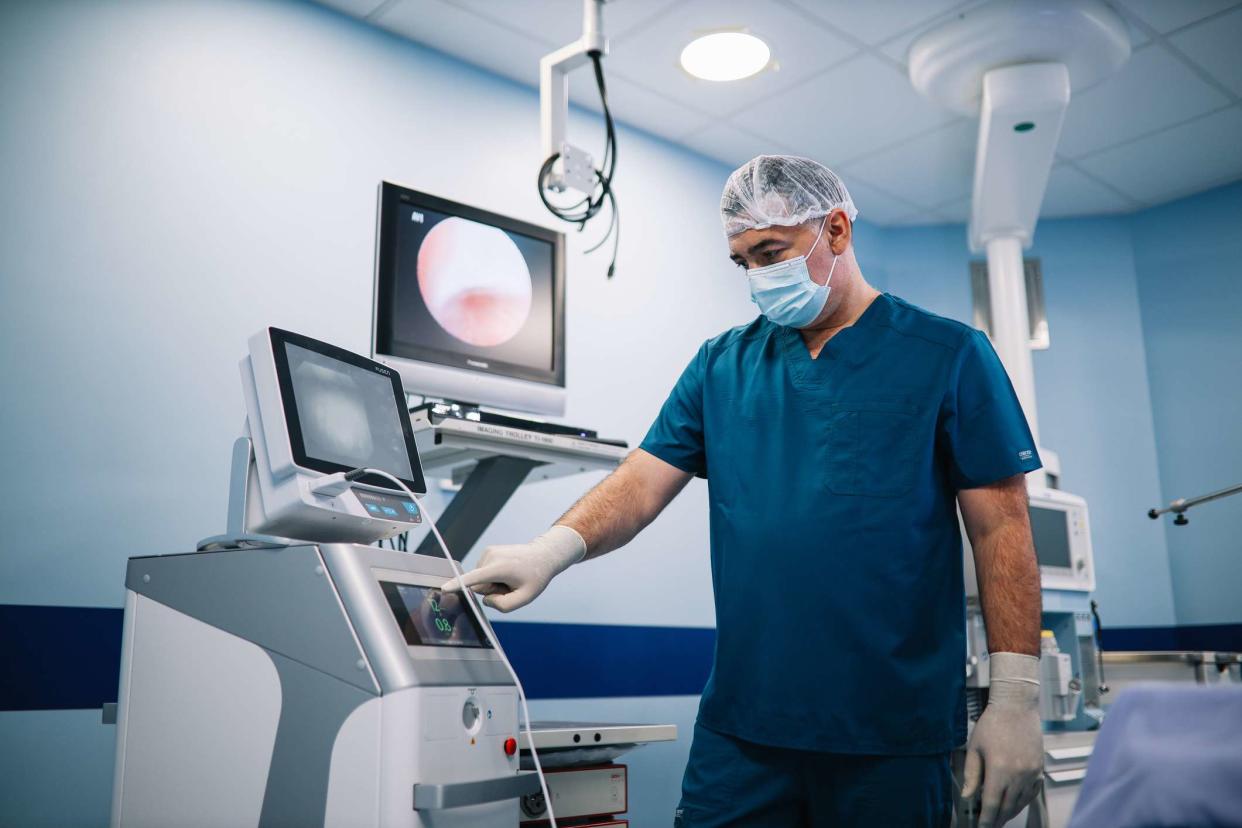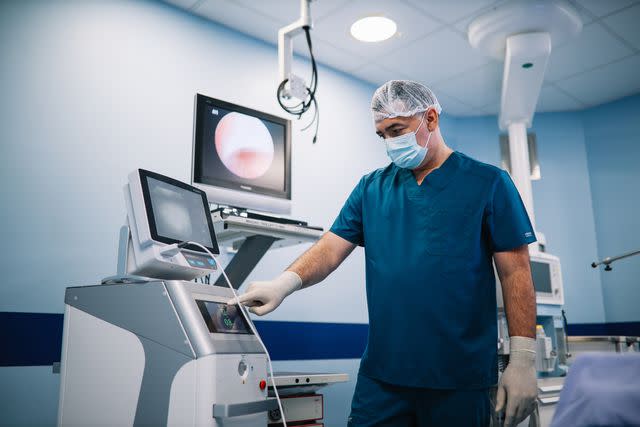Diverticulitis and Colonoscopy: What to Know

lechatnoir / Getty Images
Medically reviewed by Robert Burakoff, MD, MPH
Most people do not know they have diverticula (small outpouchings in the lining of the colon). These are sometimes discovered during a colonoscopy that’s done to screen for colon cancer.
As people age, they can develop diverticula—a condition called diverticular disease. Diverticula usually do not cause any problems. But if they become inflamed, which is known as diverticulitis, they may cause symptoms such as pain.
When diverticula are inflamed and causing symptoms, a colonoscopy is normally not done. Instead, a colonoscopy and/or other tests might be done several weeks later after the diverticulitis is under control.
This article will discuss how a colonoscopy can reveal a diagnosis of diverticular disease, how a colonoscopy is used after diverticulitis treatment, and how to develop habits for a healthy colon.

lechatnoir / Getty Images
A Diverticulitis Colonoscopy Diagnosis
A colonoscopy is a test done to look at the inside of the colon. A healthcare provider inserts a thin tube with a light and a camera on the end into the anus and up through the rectum and the other parts of the large intestine. You usually are given medication and are asleep during this test.
It's not uncommon to find one or more diverticula during a colonoscopy to screen for colon cancer. A screening colonoscopy is recommended for most people at an average risk of developing colon cancer once they reach age 45.
As people age, diverticular disease becomes more common. It is less common in people under the age of 40 years. However, it has been increasing in this group in recent years.
Diverticular disease is the most common condition that's found during a colonoscopy. Between the ages of 50 and 59 years, about 33% of people have diverticula in their colon. For those over the age of 80 years, the estimate goes up to 71%.
Most people with diverticular disease will not have any problems. Between 4% and 5% of people will have symptoms, which are usually due to uncomplicated diverticulitis. Of that low percentage with diverticulitis, about 20% will have complicated diverticulitis.
It is possible, though unlikely, that diverticular disease could be missed during a colonoscopy. A colonoscopy may not be completed because of poor prep or other reasons, like narrowed areas of the colon (strictures), making it difficult for the scope to pass through and, therefore, preventing those areas from being seen.
One study found that after having diverticulitis, a colonoscopy missed finding the diverticula in about 8% of people. The study authors point out that completing a colonoscopy is more difficult in people with a history of diverticulitis.
Another test, such as a computed tomography (CT) scan, might be used if a colonoscopy can't be completed.
Related:Potential Diverticulitis Complications
A hemorrhoid is a swollen vein in the anus or rectum. They may cause pain, bleeding, or itching. However, some people don’t know they have hemorrhoids because they have no symptoms. Hemorrhoids might be found during a colonoscopy. They can often be managed with at-home care or, uncommonly, with surgery.
Diverticulosis Diagnosed From a CT Scan
Diverticular disease might also be diagnosed with a CT scan. A CT colonography is a test that uses X-rays to create an image of the structures in the abdomen.
CT colonography might be done to screen for colon cancer for those who can’t or don’t want to have a colonoscopy. Diverticular disease might be found during such a screening. A CT scan done to diagnose the cause of digestive system symptoms could also find diverticula.
A CT scan can help diagnose diverticulitis. It is a commonly used test when diverticulitis is suspected. This test can help rule in or out diverticular disease for symptoms in the gut.
Related:How Diverticulitis Is Diagnosed
Do You Need Another Diverticulitis Colonoscopy After Treatment?
When feeling better after having diverticulitis, a colonoscopy might be recommended. There could be differences based on prior history, if there are any other problems in the digestive system, and if there were any complications from the diverticulitis.
Diverticulitis can be complicated or uncomplicated. In uncomplicated diverticulitis, there are no complications, and it is often treated at home. In complicated diverticulitis, there are other problems like an abscess (a pocket of pus in the body) or a fistula (an abnormal tunnel between two organs). Complicated diverticulitis might need to be treated in the hospital.
Some studies have found that people who were diagnosed with diverticulitis using a CT scan might be at a slightly higher risk of having colon cancer. For that reason, a follow-up colonoscopy might be recommended after uncomplicated diverticulitis.
In the case of a recent CT scan that was normal besides the uncomplicated diverticulitis, a colonoscopy might not be needed.
Related:Diverticulitis Treatment
Colonoscopy Guidelines for Patients With Diverticular Disease
A colonoscopy is often used in the management of diverticular disease. In diverticulitis, it could be used at different points, depending on the seriousness of the symptoms. There may be differences between how frequently healthcare providers request a colonoscopy is used in diverticular disease.
One review of medical literature recommends the following criteria for when a colonoscopy should be performed for people with divierticular disease:
For bleeding in the lower digestive system that’s thought to be from diverticular disease, a colonoscopy should be done within 24 hours. The regular procedure to clean out the colon of stool before the test is recommended.
When a person has acute diverticulitis, a colonoscopy should be done seven days after symptoms start. Enemas can be used instead of the complete colonoscopy prep.
For uncomplicated diverticulitis, a colonoscopy can be done six weeks after symptoms started, but only if a colonoscopy or another test like CT colonography was not done recently.
For complicated diverticulitis, a colonoscopy should be done six weeks after the symptoms started.
For people with diverticular disease without any symptoms, there is no preferred timeline for how often a colonoscopy is needed. A healthcare provider—usually a gastroenterologist or a colorectal surgeon—will give a recommendation. It could be as short as five years or as long as 10 years between colonoscopies for diverticular disease.
Related:How Often Should You Get a Colonoscopy?
Healthy Colon Habits With Diverticulosis or Diverticulitis
Diverticulitis causes symptoms in the gut, usually pain, and also either diarrhea or constipation. When the symptoms start, you may need to go on a liquid diet for a few days.
After a few days, the diet might be expanded to include more foods. After about a week, there may be another appointment with a healthcare provider to check progress. After about six weeks, the colon may be healed enough for a follow-up colonoscopy.
Many people feel better about two weeks (or sooner) after an uncomplicated diverticulitis flare-up. If symptoms persist longer than that, consider following up with a healthcare provider.
A few lifestyle changes might be recommended for diverticular disease that’s not causing any symptoms (diverticulosis). These include:
Eating a diet high in fiber or adding a fiber supplement
Eating less meat
Getting regular exercise
Stopping smoking
A healthcare provider can help in making changes to try to prevent a flare-up of diverticulitis. It might not be possible to avoid diverticulitis altogether. But for those who had a bout with diverticulitis or have chronic symptoms, it may help to work with a healthcare provider to create a management plan.
Symptoms of diverticulitis are a reason to go to a healthcare provider. Diverticulitis might be treated at home, but it needs to be diagnosed to make sure there are no complications.
Severe abdominal pain should be checked out immediately. Rectal bleeding, fever, nausea, and vomiting, along with abdominal pain, are also reasons to see a healthcare provider as soon as possible.
Related:Does Diverticulitis Go Away?
Summary
A colonoscopy is a helpful tool for diverticular disease. Especially where there are severe symptoms or bleeding that might be from diverticulitis, a colonoscopy might be done right away.
Follow-up colonoscopies are usually done after the symptoms of diverticulitis clear up. A colonoscopy every so many years might be needed to keep an eye on diverticular disease or other problems in the colon.

